Bronze Whaler Shark
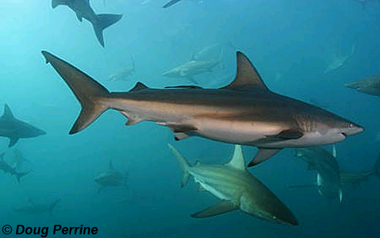
Carcharhinus brachyurus
This shark gets its name from its bronzy-grey to olive-green coloring. It is the only species of requiem shark in the genus Carcharhinus that lives in temperate rather than tropical waters. They occur throughout the world but the distribution is patchy, with what appear to be regionally isolated populations that have little exchange between them (Compagno et al. 2005).
Order – Carcharhiniformes
Family – Carcharhinidae
Genus – Carcharhinus
Species – brachyurus
Common Names
English language common names for this species include narrowtooth shark, bronze whaler, cocktail shark, cocktail whaler, and copper shark.
Other common names include:
bronzie (Afrikaans)
koperhaai (Afrikaans, Dutch)
squalo ramato (Italian)
kuroherimejiro (Japanese)
cacão (Portuguese)
tubarão-cobre (Portuguese)
tiburón cobrizo (Spanish)
tollo mantequero (Spanish)
karcharinos vrachyouros (Greek)
Importance to Humans
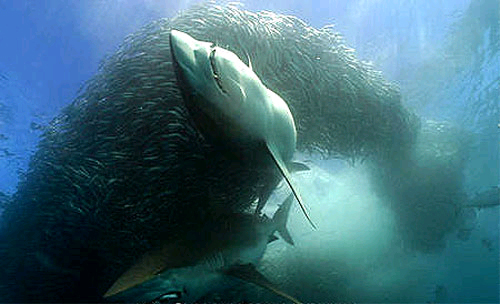
The bronze whaler shark is commercially important in New Zealand, Australia, Brazil, and South Africa. Although landing data are sparse for the bronze whaler, it is thought to be used for human consumption where it occurs. It is commonly taken in bottom trawls, by line gear and by sports fishermen (Duffy and Gordon 2003).
Danger to Humans
According to the International Shark Attack File, the bronze whaler shark has been implicated in fifteen attacks since 1962, one of which resulted in a fatality. It is considered potentially dangerous to humans (ISAF 2018).
View shark attacks by species on a world mapConservation
IUCN Red List Status: Near Threatened
The bronze whaler was listed as “Near Threatened” on the IUCN Red List in 2003. This assessment is based on the fact that it does not appear especially abundant anywhere. Instead, it appears sparsely distributed across small regional isolated populations around the world. The bronze whaler is locally common in some parts of its range; There have been population declines in New Zealand that have been attributed to overfishing (Duffy and Gordon 2003).
> Check the status of the bronze whaler shark at the IUCN website.
The IUCN is a global union of states, governmental agencies, and non-governmental organizations in a partnership that assesses the conservation status of species.
Geographical Distribution
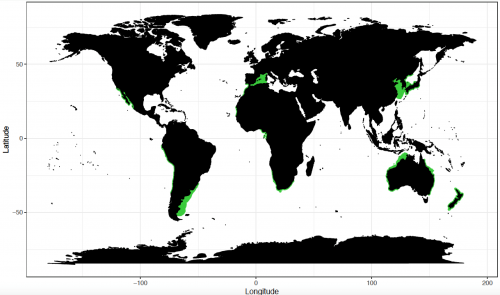
The bronze whaler shark has a worldwide distribution in warm temperate and subtropical waters in the Indo-Pacific, Atlantic, and Mediterranean (Compagno et al. 2005).
Habitat
The bronze whaler shark commonly occupies a variety of habitats from shallow bays and estuaries to inshore and continental shelf areas. It has been found from the surf line to depths of up to 328 feet (100 m), but is believed to range deeper (Duffy and Gordon 2003).
Biology
Distinctive Features
The bronze whaler shark is a large classically shaped requiem with a pointed snout. It has characteristic narrowly triangular hook-shaped teeth. The upper teeth are sexually dimorphic, the males having proportionately longer and more hook shaped teeth than the females and juveniles. The eyes of this shark are circular and relatively large. Bronze whaler sharks have moderately large pectoral fins with narrowly rounded or pointed tips. The caudal fin has a bulge near the base of the front edge. This species lacks an interdorsal ridge (Compagno et al. 2005).
The shark is sometimes confused with dusky shark (Carcharhinus obscurus), blacktip shark (Carcharhinus limbatus), sandbar shark (Carcharhinus plumbeus), and spinner shark (Carcharhinus brevipinna), it can be distinguished by its distinctive upper teeth as well as the lack of any pronounced body markings and lack of an inter-dorsal ridge (Compagno et al. 2005, Duffy and Gordon 2003).
Coloration
The bronze whaler shark is bronzy grey to olive-grey in color on its dorsal surface and white on the ventral surface. This counter shading serves to camouflage the animal from predators or prey below. This species has dark markings on the edge of its fins and white or dusky tips. Bronze whaler sharks are often confused with blacktip sharks or spinner sharks because of their markings (Compagno et al. 2005).
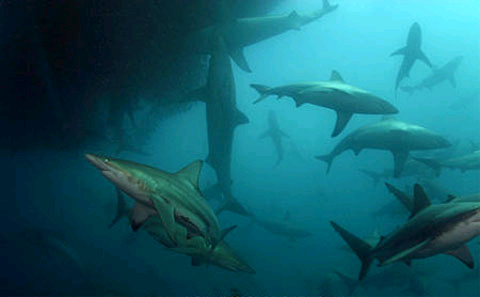
Dentition
Juvenile bronze whaler sharks have teeth in the upper jaw that are finely serrated and have erect symmetrical cusps. Adult bronze whaler sharks on the other hand, have narrowly triangular finely serrated cusps in the center of the upper jaw, which become more oblique as they move out towards the corners of the mouth. The lower teeth are characterized by more oblique cusps and are finely serrated as well. Tooth counts range from 14 to 16 on either side of the upper jaw and 14 – 15 on either side if the lower jaw. Upper jaw teeth are sexually dimorphic in adults – see above
Size, Age, and Growth
Bronze whaler sharks grow to maximum size of around 295 cm, but may attain lengths of 350 cms in rare cases . Size at maturity for males is 206-235 cm and 227-244 cm for females. The age at maturity is estimated at 13-19 years for males and about 20 years for females. Bronze whaler sharks are about 60 cm in length at birth (Duffy and Gordon 2003).
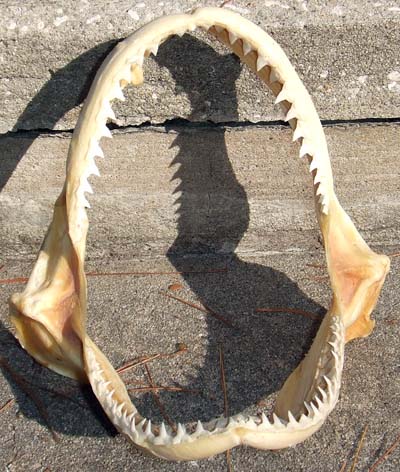
Food Habits
The diet of the bronze whaler shark consists of a variety of cephalopods including squid and octopus as well as sardines, mullet, and flatfish. During the winter months, large numbers of bronze whaler sharks follow the sardine shoals as they move along the coast of southern Natal in the “sardine run”. Adult bronze whalers are known to feed on other elasmobranchs such as stingrays and other sharks (Compagno et al. 2005, Duffy and Gordon 2003).
Reproduction
The bronze whaler is a placental vivipararous species, which means that its embryos are nourished via a placental connection to the mother and are born alive. Gestation is estimated to last 12 months and reproduction occurs biennially. According to the limited data available, pups are born from June to January and litters contain between 7 to 24 pups with an average of 15 and are approximately 60 cms TL at birth. The bronze whaler uses inshore bays as nursery areas (Duffy and Gordon 2003).
Predators
Larger sharks may prey on juvenile bronze whales
Parasites
Otodistomum veliporum is a type of fluke that has been found in the stomach and spiral valve of bronze whaler sharks in Brazil. Cathetocephalus australis is a tapeworm that can also be found in bronze whaler sharks from the southwestern Atlantic Ocean (Schmidt and Beveridge 1990).
Taxonomy
Günther first described Carcharhinus brachyurus in 1870. Synonyms include Carcharias lamiella Jordan and Gilbert 1882, Eulamia ahenea Stead 1938, Carcharhinus improvisus Smith 1952, Carcharhinus rochensis Abella 1972, Carcharhinus remotoides Deng, Xiong and Zhan 1981, and Carcharhinus acarenatus Morenos and Hoyos 1983. The genus name Carcharhinus is derived from the Greek “karcharos” meaning sharpen and “rhinos” meaning nose; the species name brachyurus means “short-bodied”.
References
Compagno, L., Dando, M., & Fowler, S. (2005) A Field Guide to the Sharks of the World. London: Harper Collins Publishers Ltd.
Duffy, C. & Gordon, I. (SSG Australia & Oceania Regional Workshop, March 2003). 2003. Carcharhinus brachyurus. The IUCN Red List of Threatened Species 2003: e.T41741A10551730.
Schmidt, G. D., & Beveridge, I. (1990). Cathetocephalus australis n. sp.(Cestoidea: Cathetocephalidae) from Australia, with a Proposal for Cathetocephalidea n. ord. The Journal of Parasitology, 337-339.
Revised by Lindsay French and Gavin Naylor 2018
Original preparation by Michelle Press